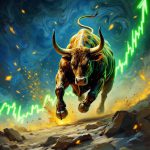Kondratiev Winter: Overhyped and Poor in Delivering Results
Jan 25, 2025
Introduction:
“Kondratiev Winter”—the mythical doom phase of long economic cycles—gets hailed like a chilling prophecy: markets frozen solid, growth sputtering to a standstill, and humanity shivering in an endless blizzard of despair. Yet despite decades of chatter, the reality remains maddeningly underwhelming. Self-appointed gurus brandish these grand theories of twenty-to-sixty-year cycles, claiming that catastrophe is certain any moment now. Ironically, we’ve endured countless recessions, booms, panics, and busts without ever encountering the dramatic “Winter” meltdown that’s allegedly inescapable. It’s time to examine whether we’ve been duped by a story more myth than material risk.
The Rise of an Overhyped Cycle
Danish economist Nikolai Kondratiev famously proposed these extended waves of economic activity—each “wave” culminating in a destructive winter, clearing the slate for new expansions. Over the years, analysts co-opted his models to hawk sweeping predictions: “A Kondratiev Winter is coming—sell everything or face devastation!” Snackable fear sells, so the phrase stuck. Yet real events rarely conform to a neat wave chart. Look at the 1970s: inflation soared, geopolitics turned volatile, and the global economy stumbled—yet it didn’t dissolve into the epic meltdown a “Winter” storyline would suggest. By the 1980s, technology innovations birthed entire industries, driving fresh expansions.
Then came the dot-com euphoria of the late ‘90s. Some cyclical adherents said we were “overdue” for a Kondratiev Winter. The internet bubble burst, and markets corrected painfully—yet not near the predicted apocalypse. In less than three years, many stock indices found their footing again, catalyzed by telecom, data, and consumer technology innovations, so much for the unstoppable freeze.
History’s So-Called Winters
- The Great Depression (1930s): Commonly cited as the “true” Kondratiev Winter—industry collapsed, joblessness soared, and economics textbooks told a cautionary tale. But was it a distinct wave of “winter” or a confluence of policy mistakes, the aftermath of WWI, and a global currency crisis?
- The 1970s Stagflation: Another candidate for “Winter,” with punishing inflation and oil shocks. Yet global trade and productivity eventually roared back stronger, culminating in a boom during the ‘80s.
- The 2008 Financial Crisis: If ever the cycle theorists had a chance to point and say, “Look! Winter!” this was it. Housing collapsed in a slow-motion avalanche, banks tottered on the brink, and the global economy gasped for air. But swift interventions, bailouts, and the unstoppable march of technology spurred a rebound that defied the notion of a multi-decade nuclear winter.
Why Kondratiev Winter Disappoints
What the doom prophets fail to consider is that markets and societies adapt. Economic cycles certainly exist but aren’t locked into a snowbound narrative. Governments implement fiscal and monetary policy to manage downturns; companies pivot faster than ever, tapping new frontiers in tech, e-commerce, and biotech. Capital is borderless, forging alliances and fueling growth in unexpected corners of the globe. Even demographic shifts—an ageing population in one region balancing out a youthful surge in another—blunt the one-size-fits-all gloom. In short, global complexities often disrupt the neat cyclical timing that the “Winter” crowd tries to sell.
Complicating matters is the cyclical crowd’s fluid timeline. They’ll say, “We’re in the early stage of Winter; just wait,” then revise that to, “The meltdown’s delayed by government manipulations, so hold tight!” The cataclysm merely keeps shifting, never quite landing. Meanwhile, real investors must navigate volatility in real time, focusing on fundamentals, risk management, and ever-evolving consumer behaviors—rather than cosmic-sounding theories that rarely prove actionable.
Tactics for True Resilience
Break Free from Fear-Driven Investing
Fear is a terrible portfolio manager. Don’t hinge your financial future on apocalyptic fantasies. Build a fortress by diversifying across bonds, equities, commodities, real estate, and cash. These aren’t just safety nets—they’re weapons to counter the market’s chaos. True resilience isn’t about bracing for doom but staying agile and prepared.
Bet Big on Disruption
“Winters” don’t just freeze economies—they forge revolutions. The 1930s ushered in consumer goods dominance, and crises like 2008 gave us fintech and mobile-first markets. Look where the heat rises: AI, green energy, biotech, space exploration. Betting on tomorrow’s disruptors beats cowering under the weight of yesterday’s failed cycles.
Decode Central Bank Signals
Forget arbitrary ice-age theories; monetary policy is where the real power lies. When the Fed pivots, markets move. Shifts in bond yields, lending standards, or consumer sentiment ripple far louder than any cyclical prophecy. Watch the hands on the economic levers, not the clouds on the horizon.
Cut Through the Noise
Economic winters make for thrilling headlines, but drama isn’t data. Strip the theatrics and dig into reality: corporate earnings, productivity trends, demographic shifts, and global trade flows. The market’s true story isn’t in a trailer for catastrophe—it’s in the fine print of progress.
Resilience isn’t about enduring winters but seizing the opportunities that every storm uncovers. Be the predator, not the prey.
Confronting the Myth
Cyclical theories have their place—they’re invaluable for mapping the macro rhythms that underpin economies. But exalting any singular wave model, particularly the vaunted “Kondratiev Winter,” distorts the true complexity of market dynamics. The persistent failures of these Winter forecasts serve as a glaring reminder: economies are not mechanical clocks, ticking predictably toward doom. Technology evolves, policymakers intervene, and global interconnectivity reshapes trajectories in ways no rigid chart or theory can fully anticipate.
Fortune may favour the prepared, but it doesn’t reward blind allegiance to doomsday prophecy. Paranoia isn’t a strategy—it’s a liability. Instead, embrace nuance. Hunt for tangible signals, test timelines, and dissect market realities with both a fox’s tenacity and a bear’s strength. Your capital doesn’t thrive in fear; it grows through disciplined adaptability.
Look past the shadows of overhyped collapse narratives, and you’ll find an economic world alive with untapped opportunity. Every market cycle isn’t the harbinger of an endless winter—it’s a forge where challenges temper innovation and fresh possibilities emerge. The wise see survival in the cycle and the seeds of reinvention. Are you watching closely?
Alchemy of Thought: Turning Questions into Wisdom















